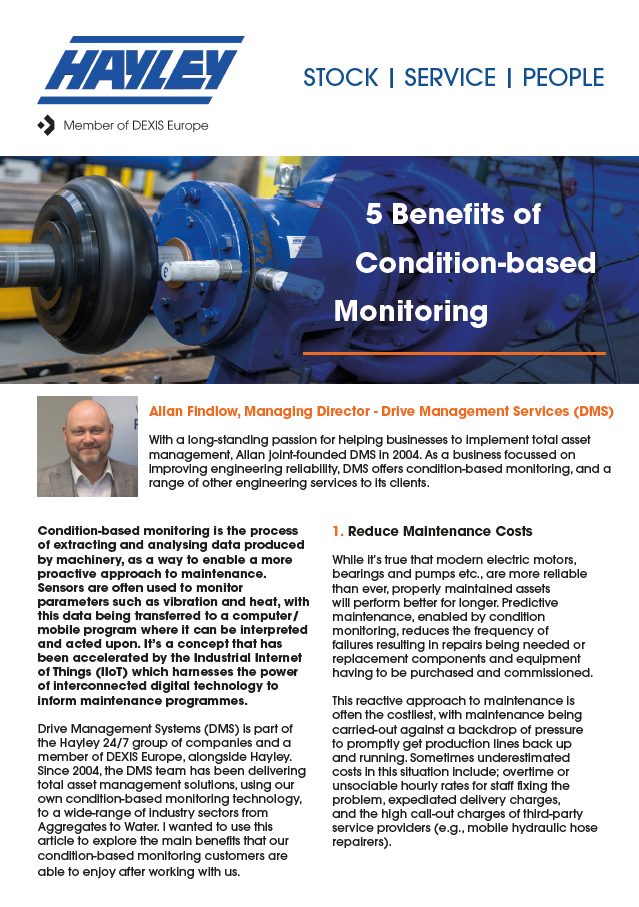Allan Findlow, Managing Director - Drive Management Services (DMS)
With a long-standing passion for helping businesses to implement total asset management, Allan joint founded DMS in 2004. As a business focussed on improving engineering reliability, DMS offers condition-based monitoring, and a range of other engineering services to its clients.
Condition-based monitoring is the process of extracting and analysing data produced by machinery, as a way to enable a more proactive approach to maintenance. Sensors are often used to monitor parameters such as vibration and heat, with this data being transferred to a computer/ mobile program where it can be interpreted and acted upon. It’s a concept that has been accelerated by the Industrial Internet of Things (IIoT) which harnesses the power of interconnected digital technology to inform maintenance programmes.
Drive Management Systems (DMS) is part of the Hayley 24/7 group of companies and a member of DEXIS Europe, alongside Hayley. Since 2004, the DMS team has been delivering total asset management solutions, using our own condition-based monitoring technology, to a wide-range of industry sectors from Aggregates to Water. I wanted to use this article to explore the main benefits that our condition-based monitoring customers are able to enjoy after working with us.
1. Reduce Maintenance Costs
While it’s true that modern electric motors, bearings and pumps etc., are more reliable than ever, properly maintained assets will perform better for longer. Predictive maintenance, enabled by condition monitoring, reduces the frequency of failures resulting in repairs being needed or replacement components and equipment having to be purchased and commissioned. This reactive approach to maintenance is often the costliest, with maintenance being carried-out against a backdrop of pressure to promptly get production lines back up and running. Sometimes underestimated costs in this situation include overtime or unsociable hourly rates for staff fixing the problem, expediated delivery charges, and the high call-out charges of third-party service providers (e.g., mobile hydraulic hose repairers).
A preventative maintenance programme stipulates components and machinery are simply replaced for new after a certain amount of time (e.g., often between 30 40000 hours for a modern electric motor), regardless of condition. This too is an approach that can come with high costs that are sometimes unnecessary. Instead, by harnessing data-led insight to guide, shape and prioritise your maintenance activity, condition monitoring can improve the service life of machinery, improving your ROI across the plant.
2. Reduce unplanned downtime
Identifying trends, weak points, and being alerted to equipment operating outside of its normal constraints by way of temperature or vibration signature, carries with it a major benefit of reducing the risks associated with unanticipated mechanical failure. Unplanned stoppages can lead to all manner of issues for our customers. Revenue is hit with production being lost with every passing hour in manufacturing environments and sometimes hefty penalties can be issued for non-delivery of contractual obligations, particularly in aggregates and building materials industry sectors. Tackling issues before they manifest into something more damaging is what condition-based monitoring is all about.
3. Improve productivity
As condition monitoring technologies are able to alert relevant personnel on-site before a fault develops into something more damaging, businesses are able to improve overall productivity. Improving the availability of machinery by carrying-out smaller maintenance tasks throughout its service life and avoiding larger problems from occurring, means that machinery is able to perform reliably for longer and production capacity is increased. Staff working around the plant are able to be more productive too, with fewer mechanical issues affecting their output.
A data-led maintenance programme also enables more accurate production plans to be created, as the predictive power of a condition monitoring solution is realised. Better-informed production plans lead to more precise delivery estimates, resulting in happier customers.
4. Improve maintenance team efficiency
Both reactive and planned maintenance activities consume your maintenance resource. No matter the size of your maintenance team, the time and energy of those staff is wasted just as much in both unplanned breakdown and diarised stoppage scenarios. Using condition-based monitoring will enable your maintenance team to focus their efforts on the areas of the plant that need attention prior to failure, rather than simply on what has already failed or what may not be anywhere near experiencing issues.
Due to the invasive nature of some maintenance tasks, Maintenance Induced Failure (MIF) is also a risk associated with planned maintenance that can be avoided by Maintenance Engineers not devoting time to unnecessary activities.
5. Better protect worker safety
Another core benefit that I want to cover here is that condition-based monitoring helps to improve the overall safety of personnel working on site. Sensors detect changes that are indicative of developing faults, allowing action to be taken before the problem has the potential to cause a risk to workers. For instance, serious mechanical failure can present all manner of health and safety risks depending on the application. Disassembly of fasteners threatening machine integrity, debris creation and the unintentional release of toxic substances are all potential risks in certain applications that can be avoided by monitoring parameters such as vibration and thermal variation.
DMS support Hayley Group branches by delivering premium-quality condition-based monitoring and specialist analysis solutions for customers with business-critical assets. Find your nearest branch by using our online Branch Finder tool.
Find-out more about DMS, by visiting their website.




